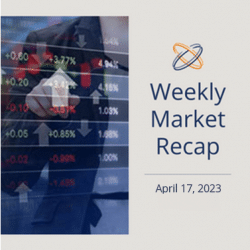Week in Review
Equity Markets:
The markets traded in a tight range last week, with all of the major indices ending positive. The S&P 500 finished the week up by 0.8%. The S&P is positive 7.8% year-to-date; despite the macroeconomic events so far this year.
Earnings season kicked into full gear last week, with the major banks starting to announce. With only 6% of the S&P 500 companies having reported, 90% have beaten earnings expectations1. This is a very small sample size and we do not expect that high of a beat rate to continue. It does point to the lowered expectations from analysts have been extreme, and earnings season could be better than expected. Consensus estimates from analysts are expecting first-quarter earnings to decline 7%2.
Fixed Income Markets:
Yields increased as bonds sold off following the inflation report and comments by members of the Federal Reserve. The 10-yr Treasury finished the week yielding 3.52% after starting the week at 3.29%. Bonds have had a strong rally over the past 6 weeks; in early March the 10-yr hit a recent peak of 4.07%.
The minutes from the Federal Reserve’s March meeting were released. This was the first meeting following the weakness in the regional banking sector. The minutes revealed that they believe the banking system is still strong, but there could be isolated incidents. The Fed also believes credit conditions are likely to tighten which is likely to cause a slowdown in the economy through the end of the year.
Economic:
The CPI reading from last week showed incremental reductions with headline and core coming in near expectations. Core CPI (excluding food and energy) rose 5.4% year-over-year while the headline number rose 5% year-over-year. PPI, which indicates the prices paid by producers, rose a modest 2.7% year-over-year. The Producer Price Index is seen as a leading indicator for the direction of inflation. The price paid by producers tends to take time to work its way to the consumer. Retail sales declined for the fourth month out past five in March by 1%; which points to consumer strength softening.
Looking Ahead
Equity Markets:
With first-quarter earnings underway, we believe this quarter could be the set-up for the rest of the year. We are moving later in the earnings revision cycle, and if corporations can do slightly better than estimates it should be positive for the markets. The market has traditionally begun its rally before earnings trough.
There remains uncertainty from a macroeconomic point of view. The surprise regional banking incident could lead to a slowdown later in the year or early next year. We still have the view that if we do experience a slowdown, it will be on the milder side. The starting point of the labor market, consumer strength, corporate profit margins, and the strength of banks should help in avoiding a long-lasting contraction. The recent closure of Silicon Valley and Signature Bank showed that idiosyncratic risks may arise, but widespread weakness is unlikely.
We believe investors should be vigilant and remain focused on their long-term strategic allocations. During times of uncertainty, a systematic rebalancing program could provide reduced volatility and the opportunity to purchase assets that are out of favor.
Fixed Income Markets:
Following the release of the meeting minutes from March’s meeting, the market’s probability of another 25-basis point rate hike in May increased by 15%3. This could be the final hike in the current cycle. Inflation has continued to trend down, and economic weakness has started to show. We see this as positive for the fixed-income markets. We believe there is the potential to retest the 4% range, but that will likely be short-lived if that occurs. We anticipate rates to be in the 3-3.25% range over the next 6-12 months.
After the near-zero rate structure over the past few years, we believe fixed-income investors now have the ability to receive a sufficient return. And, if we do experience an economic slowdown, we expect the negative correlation from high-quality fixed income will return.
Economic:
The housing market will be in the spotlight this week with the Housing Market Index from the NAHB kicking the week off. Housing starts and existing home sales will be released later in the week. The Conference Board Leading Economic Index will be released on Thursday. The LEI has fallen for eleven consecutive months4.
Sources:
1)FactSet
2)Yardeni Research, Inc.
https://www.yardeni.com/pub/yriearningsforecast.pdf
3)CME Group
https://www.cmegroup.com/markets/interest-rates/cme-fedwatch-tool.html
4)The Conference Board Leading Economic Index.
https://www.conference-board.org/topics/us-leading-indicators
Important Disclosures:
Investment Advisory Services offered through Krilogy®, an SEC Registered Investment Advisor. Please review all prospectuses and Krilogy’s Form ADV 2A carefully prior to investing. This is neither an offer to sell nor a solicitation of an offer to buy the securities described herein. An offering is made only by a prospectus to individuals who meet minimum suitability requirements.
All expressions of opinion are subject to change. This information is distributed for educational purposes only, and it is not to be construed as an offer, solicitation, recommendation, or endorsement of any particular security, products, or services.
Diversification does not eliminate the risk of market loss. Investments involve risk and unless otherwise stated, are not guaranteed. Investors should understand the risks involved of owning investments, including interest rate risk, credit risk and market risk. Investment risks include loss of principal and fluctuating value. There is no guarantee an investing strategy will be successful. Past performance is not a guarantee of future results. Indices are not available for direct investment; therefore, their performance does not reflect the expenses associated with the management of an actual portfolio. The S&P data is provided by Standard & Poor’s Index Services Group.
Services and products offered through Krilogy® are not insured and may lose value. Be sure to first consult with a qualified financial advisor and/or tax professional before implementing any strategy discussed herein.














